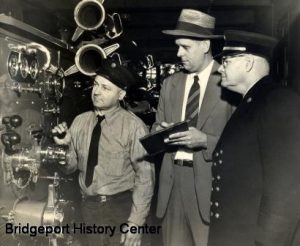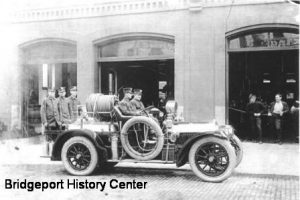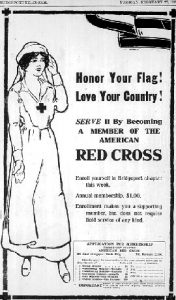Art Selleck: A Tribute to a Fireman Historian 1920-2004

By Rob Novak, Bridgeport Fireman
Arthur “Art” H. Selleck was born in Bridgeport in 1920, living there for five years before moving to Nichols. He attended Harding High School in the Park City, since Trumbull had no High School at the time. He would later recall witnessing a house fire as a youth in Nichols, (more…)
Bridgeport’s Heroic Firemen
By: Rob Novak, Bridgeport Fireman
Some years ago, fellow firefighters showed me the following excerpt in the August 2004 edition of Firehouse magazine – “August 20 1904: Bridgeport, CT – An explosion during a fire in a powerhouse of the Burritt Lumber Company hurled two men, a building employee and Fireman Thomas Weller, from the roof of the building, killing both. Twenty firemen, including the chief, were buried under a huge pile of sawdust and rescued by the firemen”.
For over a decade, I have been trying to identify Line of Duty deaths (LODD) in the Bridgeport Fire Department. For a variety of reasons, no definitive list was ever compiled, and it is my sincere belief that anyone who gave their life in the service of the City of Bridgeport deserves to be remembered. It appeared that Thomas Weller fit that criteria, but first I had to be sure. So I visited the Bridgeport History Center.
First, I checked the August 20, 1904 edition of the Bridgeport Post on microfilm, where I found a very different story. There had been a serious fire and explosion at the Burritt Lumber Company on Knowlton Street near Kossuth Street. During the explosion, firefighter Thomas Weller of Engine Company 2 and a Burritt employee were hurled a great distance and were missing for some time.
Investigating further, it appeared that Weller was thrown 60 feet from a 45’ high roof, but his landing was cushioned by a large pile of sawdust. Burned from the explosion, he picked himself up and went on his own to a nearby doctor’s office, apparently without informing anyone, and a frantic search ensued.
So now I knew that there had been an explosion, and Thomas Weller was injured, but did not die. There was no mention of 20 firemen buried, though since Kossuth Street was showered with debris it is understandable how that may have been initially reported. A week later, the Post stated that Weller was improving in the hospital. Perhaps he later took a turn for the worse and died of his injuries?
The next step was to walk across the room to the City Directories. The 1903 and 1904 editions established only one Thomas Weller lived in Bridgeport. He lived on the East Side and worked at the Wheeler & Wilson sewing machine factory near Engine 2’s Crescent Place firehouse. This revealed that Weller was in fact a “callman” – a type of auxiliary fireman who was paid only when he responded to a fire. This might explain why he left the scene without telling his superiors.
Since Weller was also listed in the 1905 and 1906 Directories, I felt I could safely conclude he did not die from injuries at this fire. So the final question was, how did a national magazine erroneously report his death a hundred years later?
Bridgeport boasted a number of local newspapers in 1904. It is likely that one or more of them went to press while Weller was missing and presumed dead. The wire services probably picked up the erroneous story, and it was reported nationwide. The Bridgeport Post, an evening newspaper, hinted this, stating “The affair caused much excitement around town, and at first it was reported both men had been killed”.
Once again, the History Center at Bridgeport Library provided the perfect one-stop venue to solve this mystery, and shed light on a long-forgotten incident from the Park City’s past.
The Progressive Bridgeport Fire Department

By Rob Novak
The Progressive Bridgeport Fire Department of 1912
One hundred years ago, the Bridgeport Fire Department was in a state of transition. Under the leadership of Fire Chief Edward Mooney, the department shed the last of its “call men” in December 1911, completing the process begun in 1871 creating a fully manned service on duty 24 hours a day.
As the number of “permanent” firemen increased, the number of fire horses decreased, from 67 at the end of 1910 to 58 one year later. This was a direct result of the progressive leadership (and political pull) of Chief Mooney, as well as Bridgeport’s own Locomobile Company.
In 1911, Locomobile was eager to expand into manufacturing fire apparatus, and Chief Mooney was eager to receive them. Locomobile had already provided Bridgeport its first two motorized apparatus by 1911 – his own fire chief’s car as well as the “Chemical 1” fire engine at the Middle Street fire headquarters. Chemical 1 carried a tank filled with carbonated water, which when mixed with a small amount of acid produced a chemical reaction (hence the fire engine’s name) which propelled water through a special hose. So successful was this chemical appliance that they were retrofitted to all remaining horse drawn hose wagons. This was the beginning of the aggressive, interior firefighting strategy which the Bridgeport Fire Department is still known for today.
In 1911, Locomobile provided two additional pieces of apparatus. The first was a motorized four-wheeled “tractor”, which was attached to an older horse-drawn steam powered fire engine. The result was an odd, six-wheeled contraption which relied upon gasoline for locomotion and a coal-fired boiler for pumping water through hoses. Assigned to Engine 5, the Bridgeport Post described it as an “ugly and clumsy looking”, and was nicknamed “the mosquito” by some, and “the freak” by others. It was difficult to maneuver, particularly when it came to backing into the narrow doors of the Middle Street firehouse. This was the first and last time Locomobile provided motor power to Bridgeport’s larger fire engines. When John Street’s Engine 1 returned from Wisconsin rebuilt with a new motorized tractor, the Locomobile tractor was quietly removed from Engine 5 and it reverted to being a horse drawn fire engine. Nevertheless, this short-lived Locomobile can be considered Bridgeport’s first large motorized engine.
A second Locomobile was provided to Bridgeport at the same time, and it was far more successful. Assigned to the newly organized Chemical 2 in a new firehouse on Maplewood Avenue, it remained in service for about 15 years. Locomobile also provided similar fire engines to the Fairfield, Stratford, and Ansonia fire departments around this time.
By the end of the first quarter of 1912, the Bridgeport Fire Department had 8 active motorized fire apparatus, more than any other in Connecticut. Six of these apparatus (2 chemical engines, 2 chief’s cars, and 2 hose wagons) were Locomobiles. The remaining two were Engine 1’s Nott tractor-driven steamer, and a new Waterous gasoline powered fire engine assigned to Engine 2 on Crescent Place. It is interesting to note that at this time in history the Bridgeport Police Department had only one motorized “police patrol”, and there was only one motorized ambulance in the City.
World War One Era in Bridgeport

